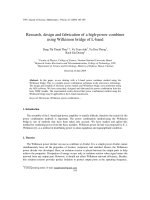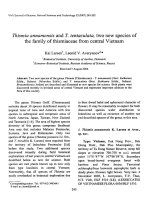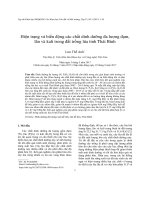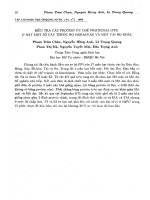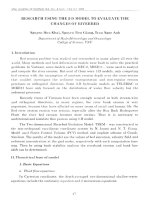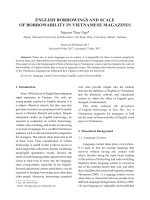DSpace at VNU: Research, design and fabrication of a high-power combiner using Wilkinson bridge of L-band
Bạn đang xem bản rút gọn của tài liệu. Xem và tải ngay bản đầy đủ của tài liệu tại đây (887.93 KB, 5 trang )
VNU Journal o f Science, Mathematics - Physics 25 (2009) 185-189
Research, design and fabrication o f a high-power combiner
using Wilkinson bridge o f L-band
Dang Thi Thanh Thuy' *, Vu Tuan Anh^, Vu Duy Thong^,
Bach Gia Duong^
Faculty o f Physics, College o f Science, Vietnam National University Hanoi
’Research Center Electronics and Telecommunication, College o f Technology, VNU
D epartment o f Science and Technology, Ministry o f Defense, Hanoi, Vietnam
Received 24 June 2009
Abstract. In this paper, we are dealing with a L-band power combiner method using the
Wilkinson bridge. This is a modem power combination technique in the microwave technology.
The design and simuỉink o f the basic power moduls and Wilkinson bridge were performed using
the ADS soflware. We have researched, designed and fabricated the power combination from the
basic 200W moduls. The experimental results showed that power combination method using the
Wilkinson bridge may be applicable in the L-band transmission.
Keyword: Microware, Wilkinson, power combination....
Ỉ. Introductiun
The assem ble o f the L-band high-pow er amplifier is usually difficult, therefore the search for the
pow er com bination m etho ds is important. The pow er com bination m ethod using the Wilkinson
bridge IS one o f m eth ods that have been taken into account. W e have studied and aplied this
method ibr co m bin in g po w er from the basic modules. W ilkinson p ow er divider was proposed by E. J.
Wilkinson [ 1], as a m e th o d o f distributing pow er to attain equiphase and equiam plitude condition.
2. Theories
The W ilkinson p o w e r divider can use as com biner or divider. It is a simple pow er divider cannot
simultaneously have all the properties o f lossless, reciprocal, and matched. Hence, the W ilkinson
power divider w as developed. Here, an isolation resistor is placed betw een the output ports to help
achieve the properties. D issipation o f energy occurs only in isolation resistor w hen signal enters the
network from any o u tp u t port. H ow ever, it should not affect W ilkinson netw ork efficiency. Besides,
this isolation resistor provides perfect isolation to protect output ports at the operating frequency.
Correcsponding author. E-mail:
185
186
D. T. Thuy ei cil. / VNU Journal o f Science. Mathematics - Physics 25 (2009) ỈS5-Ỉ89
Generallv, W ilkinson p o w e r d iv id er can have anv nu m ber o f output ports. A basic three por
W ilkinson pow er divider o f p o rt characteristic impedance Zo is schem atically show n in Figure I .
Fig. 1. Schematic diagram of aWilkinson power divider [1].
This IS a such netw ork that the lossless and resistive T-junction p ow er dividers have no isolation
b etw e en the ou tp u ts o f p ort 2 an d p ort 3, and the lo s s le s s d iv id er IS n ot m a tch ed at all p orts, and the
resistive pow er divider is lossy. T h e W ilkinson pow er divider has all ports m atch ed and has isolation
between output ports, b u t is lossy [1]. T he W ilkinson pow er divider is a 3-port device with a scattering
matrix of:
- J
0
- j l ề
( 1)
0
Note this device IS m atched at port 1 (S n = 0), and we find that m agnitude o f colum n 1 is:
S..
oSp
i l
’
S
21
'
0s,.
3 1
“
1
(2)
Ihus, ju s l like the lossless d iv id er the incident pow er on port 1 IS evenly and cííicicnily divided
between the outputs o f port 2 and port 3. But now look closer at the scattering matrix. Wc also note
that the ports 2 and 3 o f this d ev ice are matched. It looks a lot like a lossless 3dB divider, only with an
additional resistor b etw ee n p o rts 2 and 3 .
3. Design W ilkinson p o w e r d ivid er
We simulate the W ilk inso n brigdc by ADS solfware (figure 2a), the frequency o f transmission
signal is 1030 M Hz, w e retrieve the S-matrix param eter m agnitudes depicted in Figure 2b, 2c. The
1030 M H z frequency w as studied because this frequency will application in our the next rescach for
design and fabrication o f a tran sm itter system for the phase identification code.
D T. Thuy el al. / \'NIJ Journal o f Science, Maihemaiics - Physics 25 (2009) Ỉ 85-189
r—
------------n
mi
ĨH Ũ
TU
WTo:_AO.S
Su0st='MSucr
Sut»t=*MSubr
W=1 53303 rm {Q
w = 2 96 3 2 3 0 rrm
L=40 3207rTĩn{ạ
n
le fT
s
s
Him =2
87
TifrrC
z= 500hm
L=10frm{-t)
1
1 T n-i
- í
TL1
Subsr^WSuCl*
0— V
^^29632XrTm
Ĩwm1 L=lQfmi{-t}
2=50 Ohrr
R1
ftiiOOOfvn
SuDsp'fcejcr
WM53rm
W 3 = 2 9 6 3 ittti
Subst^-MSdbt'
‘.I?i
T112
Sutet^^-MSubl'
V^lS33C3fTTTi{1}
W=r2 96 3 2 3 0 m
L--415207fiTn(ị
L=10rrm{-t}
'A \
Ĩ1 1 3
I
Terr--
T«rrM
^*ấI»=3
z=500m
(a)Tlie Wilkinson by ADS solfware
.m2
■freq=1 030GHz
m1
;freq=1 030GHz
ỜB(S(2.1))=-3 011
,dB(S(2,2))=-39 305
Ũ
ml
-1 0 -
COfN*- -20-.
é ể i •30-
•CT5T5
t y
-40-50 •
02
04
06
10
12
14
16
18
freq GHz
freq, GHz
(b)S
parameter mamiitude
(c) s parameter magnitude
FMg. 2. T h e s e m u lin k results.
Base on W ilkinson brigde niclhods, wc propose a com bination m e th o d s from the medium power
mociul and the small pow er modul (Figure 3).
2()()W
Fig. 3. The power combining use Wilkinson brigde.
4. Experim ents result
We have designed and fabricated the 200W amplifier m od ules from the smaller ones. The basic
modules w ere designed by using the microtrip technology [4], w hich are small and portable (figure
4a). After simulink modelling, the W ilkinson bridge was designed usin g the modern accurate circuit
imprint technology [2,3](figure 4b)
88
D T Thỉiy et a!. / Ỉ'NU Journal o f Science, Mathematics - PhysiCs 25 (2009} ỉiS5~ỈS9
(a)
(b)
Fig. 4. T h e 2 0 0 W p o w e r am p lifie r (a) T h e W ilk in so n bridize (b).
From the basic amplifier m o d u ls and Wilkinson bridge divider we have fabricated the hiuh-pow cr
combination circuit as illustrated in figures.
hig. 5. i he integration 0Í the Ircquency combinanon circuit.
The amplifier m odules w ere carefully chccked to assure the com patibility so that the risk o f
malfuction after the integration is minimal. Obscr\Mim the working o f the 200W am p lin cr by
the network analyzer (Rolde &L S ch w arz ESPi, 9 K llz -3 G llz, lest receiver), we r c \c a le d tliat the band
width was quite wide and the am plify ing coefficient has achieved the high value within tlic trequencN
ranee 90 5M H z-1060M lỈ7 (F'ig. 6a)[4]. The signal at 1030 M H z was inputcd iiilo tlie am plifying
module and observed on the spcctrum analvzcr (Advanlcsl R3765CG (300 K lIz-3.8 G Hz)), the result
showed that at 1030 M llz the an iplifying cocfUcicnt readied high value, tlie input am plitude was set
a t-lO d B and the output one w as above 16dB. The adjustment o f current regim e m av increase the
amplifying coefficient even more. We have also investigated tlie S il factor o f the power
divider Wilkinson on network a n a ly /x r, the result was relatively similar to that o f the simulink model.
Aftcrthal we have measured the characteristics o f the pow er com biner using the W inkinson bridge.
The input am plitude from the g enerator was set at -lOdB and was directed to the am plifier module
before the divider. This pow er a m p lifier was com posed from the three m odules having the pow er IW,
45W and 200W. The output am p litu d e reached 29dB. The signal was then transm itted to the divider,
the two outputs also reached 2 6dB and were synchronized. The outputs w ere inputed to the 200W
amplifier modules. These m o d u les were set to work in the AB regim e with am plifying
D. T. Thuy et al. / \ ’NU Journal o f Science, Mathematics - Physics 25 (2009) 185-189
189
coefficient G =27 aiid the output am plitude reached 53dB. A fterthat w e utilized the Wilkinson bridge
to com bine the tw o output signals. The final amplitude was 56dB w h e n m easured with the Watt Meter
Model 4 3 -S .^ 2 8 6 0 7 0
:
.
:
,
',
!
.
.
.
j
'
*
\
11,
. . . 'C T . Í0 C 8
(a)
:0;C 5i . ;
(b)
Fiu. 6. (a) T h e f re q u en cy characteristics; (b) S p e c t r u m at 1 0 3 0 M H z .
5.
C onclusion
\Vc have designed, successfully fcibricated and tested the p o w e r com bination unit using the
Wilkinson bridge, i'he expcrimtMital results demonstrated the efficiency o f this method in
manuiacluring the larger m odules from the smaller ones and w e anticipate to applicate this method for
ilie o i il pn t p o w e r in n e a r f u t u r e
Ackncm n lc g m cn t. riie results o f this work belong to the research project K C.01.12/06-10 from State
Prouranis on Scientific Research o f Vietnam. One o f these au th ors would like to thank the support
tVom llie research proJcct Ọ T 09-13, V ietnam National University, Hanoi.
References
11|
!)aviij M l*o/ar, X iicrow ave E ngineering. 2"*^ E-^dition. John Wilcv & Sons, inc., New york. United Slate o f Amcrica,
[2]
'.i. Mchran. C'AI) ofM icroslrip i'iltcrs considering dispersion loss aiid discontinuity cITccls, IE E E Trans. S n J - 2 7 . Mar.
;1979) 239.
|3 ]
Mchran, A method o f analysis and dcsiiin o f microslrip directional couplers considering dispersion and discontinuity
ciiocls, Proc. oj ih e 1970 in fo rm a tio n a l Sym posiu m on C o m p u ter-A id ed D esig n o f the E lectrics f o r Space A pplication.
Bol 0i;na (Italy) ( 1979) 7A.
[4]
3ang I hi Thanh Thuy, !*ham Van Thanh, Nguyen Anh Tuan, Bach Gia Duong, Research, Design And Fabrication O f
1he 45W And I hc 2{)()W, I,-Band Power Amplifier Using The Modem Microstrip Technology For Application In The
National Sovereignly Identification Coding System, J o u rn a l o f Science, VN U , Vol. XXI!, N o 2AP (2008) 210.
